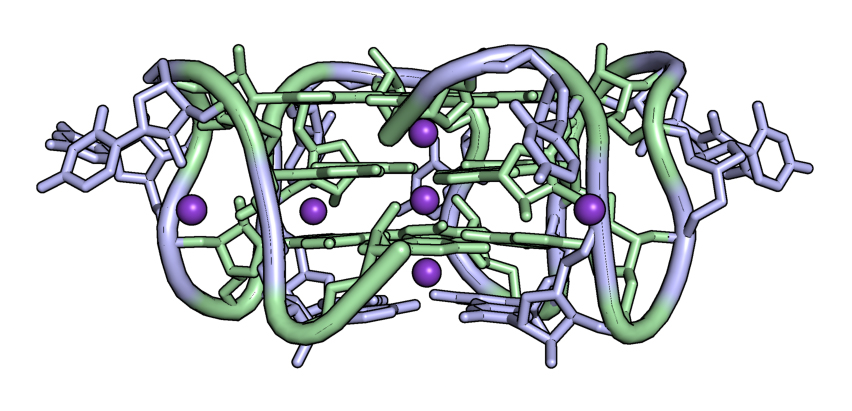Folds In pUG Molecules Turn Off Genes And Could Provide Clues About Human Disease
Genes. They’re what control the way living things look and even function, what eye color they may have and even what diseases they may live with. Scientists have worked for decades to understand how some genes get switched on while others are switched off, or silenced, determining which traits are expressed.
 The RNA quadruple helix Roschdi and Butcher study, called a “pUG”, can wind around itself four times to create a cube shape that can affect gene silencing. In this rendering, the uridine (U) nucleotides are blue while the guanosine (G) nucleotides are green. Genes. They’re what control the way living things look and even function, what eye color they may have and even what diseases they may live with. Scientists have worked for decades to understand how some genes get switched on while others are switched off, or silenced, determining which traits are expressed.
The RNA quadruple helix Roschdi and Butcher study, called a “pUG”, can wind around itself four times to create a cube shape that can affect gene silencing. In this rendering, the uridine (U) nucleotides are blue while the guanosine (G) nucleotides are green. Genes. They’re what control the way living things look and even function, what eye color they may have and even what diseases they may live with. Scientists have worked for decades to understand how some genes get switched on while others are switched off, or silenced, determining which traits are expressed.
In a study recently published in Nature Structural and Molecular Biology, biochemists at the University of Wisconsin–Madison and Harvard University have found a new piece of the puzzle by identifying an unusual cube-like RNA structure that can control gene silencing in roundworms. The basis for the structure is a sequence of nucleotides they call a “pUG.”
 Samuel E. Butcher is a senior author of the new study and the Steenbock Professor of Biomolecular Structure in the Department of Biochemistry at UW–Madison.
Samuel E. Butcher is a senior author of the new study and the Steenbock Professor of Biomolecular Structure in the Department of Biochemistry at UW–Madison.
Samuel E. Butcher is a senior author of the new study and the Steenbock Professor of Biomolecular Structure in the Department of Biochemistry at UW–Madison.
“People are familiar with the double helix of DNA,” says Samuel E. Butcher, a professor of biochemistry at UW–Madison and a senior author of the study. “This is an RNA quadruple helix that winds around itself four times into a cube shape.”
Cells have many strands of RNA, or ribonucleic acid, with different kinds of sequences and shapes. RNA has many important jobs inside of cells, like carrying instructions from DNA to make proteins, and is made up of a string of compounds called nucleotides. In the case of pUGs, or poly-uridine-guanosine, the nucleotides are repeating pairs of uridine (U) and guanosine (G).
In 2019, scientists at UW–Madison discovered an enzyme that adds pUGs to the ends of RNA molecules, forming “pUG tails.” Later, with colleagues at Harvard, they helped demonstrate that these pUG tails play a role in gene silencing in roundworms, and this gene silencing could also be inherited in their offspring — a process known as epigenetic inheritance.
 Saeed Roschdi is the lead author of the study and a PhD student in Butcher’s lab.
Saeed Roschdi is the lead author of the study and a PhD student in Butcher’s lab.
Butcher and his PhD student Saeed Roschdi, lead author of the new study, wanted to learn more.
For the last several years, they have conducted experiments to investigate how pUGs work and whether they exist in genomes beyond the roundworm. In particular, they were interested in whether pUGs take on a particular shape, or fold, since RNA sometimes must take on specific shapes to perform work.
The researchers found that, like the curlicue tails of the dogs their nickname alludes to, pUG sequences can fold tightly around themselves. This “pUG fold” is important for their ability to silence genes.
To arrive at this finding, Roschdi made a bunch of pUGs of different lengths and then analyzed them with special imaging techniques to see if and how they folded.
They discovered that 12 is the magic number. That is, pUG RNA must have at least 12 pairs of UG nucleotides in a row to form its cube-like structure and silence genes. Any fewer than 12, and the strand is too short to successfully fold around itself.
“It sort of gave us the molecular rules for gene silencing. And once we knew these rules, there’s a pattern to look for,” Butcher says.
From there, they looked for the pattern of 12 UG repeats in other genomes besides the roundworm. They found the sequence in thousands of human genes, but the sequence was in the middle of the RNA instead of on the tail end.
They suspect that these pUG sequences fold up into the same cube-like structure that controls gene silencing in the roundworm, but the structure hasn’t yet been observed in humans.
“There’s potential that it’s going to be context dependent,” Roschdi says, explaining that the pUG structures may compete with other sequences that cause the RNA to fold into a different shape.
Now, they are trying to figure out what proteins interact with the human pUG sequences. From there, they may be able to test the interactions to see how they affect gene expression in humans. Learning more about how pUGs work in humans could potentially open the door to new treatments.
“In the future, we might be able to use this information to instruct any kind of cell to silence a harmful gene,” Butcher says. “It could be viral, or a cancer-causing gene. The possibilities are numerous.”
Roschdi thinks pUG tails also provide a great opportunity to study certain human proteins that interact with pUG RNAs and are involved in neurodegenerative diseases like ALS.
Further research is necessary to determine exactly how the power of these pUG tails can be harnessed, but Roschdi is excited for the challenge.
“Obviously in an ideal world, you would just do an experiment and it would work perfectly,” Roschdi says. “But for me, as long as I’m figuring out new things, I’m motivated.”
Publication: Roschdi, S., et al. An atypical RNA quadruplex marks RNAs as vectors for gene silencing. Nature Structural & Molecular Biology, (2023). DOI:10.1038/s41594-022-00854-z
Original Story Source: University of Wisconsin-Madison

 Alerts Sign-up
Alerts Sign-up